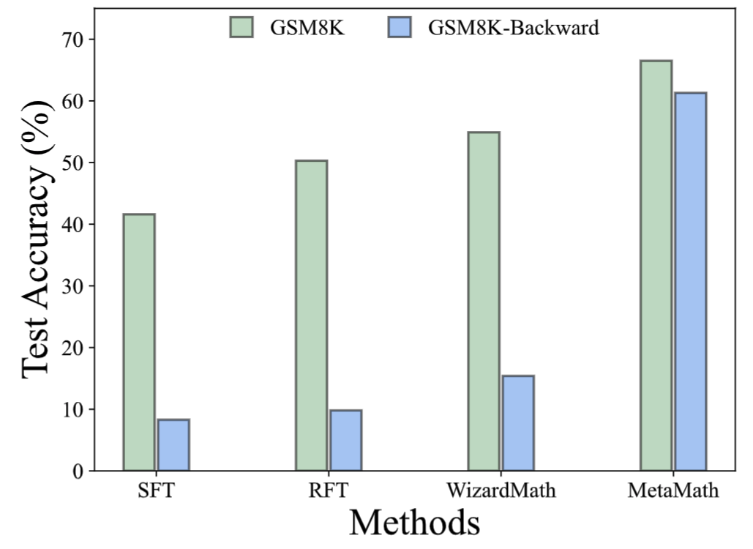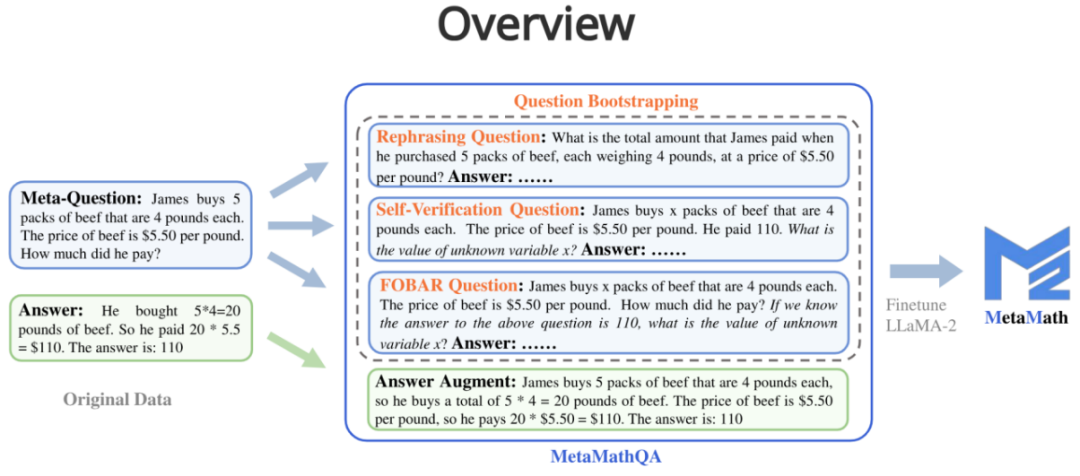逆向思维:MetaMath新数学推理语言模型训练大型模型
复杂数学推理是评价大语言模型推理能力的重要指标,目前常用的数学推理数据集样本量有限且问题多样性不足,导致大语言模型存在 [逆转诅咒] 的现象,即一个训练于「A 是 B」的语言模型无法推广到「B 是 A」[1]。此现象在数学推理任务中的具体形式是:即给定一个数学问题,语言模型擅于用正向推理解答问题但缺乏逆向推理解决问题的能力。逆向推理在数学问题中十分常见,如下 2 个例子。
1. 经典问题 - 鸡兔同笼
- 正向推理:笼子里有 23 只鸡和 12 只兔,问笼子里有多少个头和多少只脚?
- 逆向推理:有若干只鸡兔同在一个笼子里,从上面数,有 35 个头,从下面数,有 94 只脚。问笼中各有多少只鸡和兔?
2. GSM8K 问题
- 正向推理: James buys 5 packs of beef that are 4 pounds each. The price of beef is $5.50 per pound. How much did he pay?
- 逆向推理: James buys x packs of beef that are 4 pounds each. The price of beef is $5.50 per pound. How much did he pay? If we know the answer to the above question is 110, what is the value of unknown variable x?
为了提升模型的正向和逆向推理能力,剑桥、港科大、华为的研究者基于两个常用的数学数据集(GSM8K 和 MATH)提出了 MetaMathQA 数据集:一个覆盖面广、质量高的数学推理数据集。MetaMathQA 由 395K 个大语言模型生成的正向逆向数学问答对组成。他们在 MetaMathQA 数据集上基于 LLaMA-2 微调得到专注于数学推理 (正向和逆向) 的大语言模型 MetaMath,在数学推理数据集上达到了 SOTA。MetaMathQA 数据集和不同规模的 MetaMath 模型已开源供研究人员使用。

- 项目地址:https://meta-math.github.io/
- 论文地址:https://arxiv.org/abs/2309.12284
- 数据地址:https://huggingface.co/datasets/meta-math/MetaMathQA
- 模型地址:https://huggingface.co/meta-math
- 代码地址:https://github.com/meta-math/MetaMath
在GSM8K-Backward数据集中,我们构建了一个逆向推理的实验。实验结果显示,与SFT、RFT和WizardMath等方法相比,目前的方法在逆向推理问题上表现较差。与之相反,MetaMath模型在正向和反向推理方面都取得了出色的性能

方法

MetaMathQA 包含了四种数据增强的方法:
1. Answer Augmentation (答案增强):给定问题,通过大语言模型生成能得到正确结果的思维链作为数据增广。
- Question: James buys 5 packs of beef that are 4 pounds each. The price of beef is $5.50 per pound. How much did he pay?
- Answer: James buys 5 packs of beef that are 4 pounds each, so he buys a total of 5 * 4 = 20 pounds of beef. The price of beef is $5.50 per pound, so he pays 20 * $5.50 = $110. The answer is: 110.
2. Rephrasing Question (问题改写增强):给定元问题,通过大语言模型重写问题并生成得到正确结果的思维链作为数据增广。
- Question: What is the total amount that James paid when he purchased 5 packs of beef, each weighing 4 pounds, at a price of $5.50 per pound?
- Answer: Each pack of beef weighs 4 pounds, so 5 packs weigh 4 * 5 = 20 pounds in total. The price per pound of beef is $5.50, so the total cost for 20 pounds is 20 * $5.50 = $110. Therefore, James paid a total of $110. The answer is: 110.
3. FOBAR Question (FOBAR 逆向问题增强):给定元问题,通过掩码条件中的数字为 x,给定原有答案并反推 x 来产生逆向问题,并基于该逆向问题生成正确的思维链过程来进行数据增广(反推样例:“If we know the answer to the above question is 110, what is the value of unknown variable x?”)。
- Question: James buys x packs of beef that are 4 pounds each. The price of beef is $5.50 per pound. How much did he pay? If we know the answer to the above question is 110, what is the value of unknown variable x?
- Answer: James buys x packs of beef that are 4 pounds each, so he buys a total of 4x pounds of beef. The price of beef is $5.50 per pound, so the total cost of the beef is 5.50 * 4x = 22x. We are given that the total cost is $110, so we can write: 22x = 110. Dividing both sides by 22, we get: x = 5. The value of x is 5.
4. Self-Verification Question (Self-Verification 逆向问题增强):在 FOBAR 的基础上,通过大语言模型改写逆向问题部分为陈述的语句来进行数据增广(改写样例:“How much did he pay?” (with the answer 110) 被改写成 “He paid 110”)。
- Question: James buys x packs of beef that are 4 pounds each. The price of beef is $5.50 per pound. He paid 110. What is the value of unknown variable x?
- Answer: To solve this problem, we need to determine the value of x, which represents the number of packs of beef that James bought. Each pack of beef weighs 4 pounds and costs $5.50 per pound. The total amount James paid is $110. We can set up the equation as follows: Number of packs of beef * Weight per pack * Price per pound = Total amount paid; x * 4 * $5.50 = $110; Let's simplify and solve for x: 4x * $5.50 = $110; 22x = $110; To isolate x, we divide both sides of the equation by 22: 22x / 22 = $110 / 22; x = $5; The value of x is 5.
实验结果


在两个常见的数学推理数据集(GSM8K和MATH)的实验结果表明,MetaMath在性能上显著优于已有的开源LLM模型,而且不需要借助外部工具(例如代码解释器)。其中,我们的MetaMath-7B模型在GSM8K上达到了66.5%的准确率,在MATH上达到了19.8%的准确率,分别比相同规模的最先进模型高出11.6%和9.1%。特别值得一提的是,MetaMath-70B在GSM8K上达到了82.3%的准确率,超过了GPT-3.5-Turbo
根据《表面对齐假设》[2],大型语言模型的能力来自于预训练,而来自下游任务的数据则会激活预训练期间所学习到的语言模型的内在能力。因此,这引发了两个重要问题:(一)哪种类型的数据可以最有效地激活潜在知识,以及(二)为什么一个数据集在这种激活中比另一个数据集更好?
为什么 MetaMathQA 有用?提高了思维链数据的质量 (Perplexity)

根据上图所示,研究人员计算了 LLaMA-2-7B 模型在仅答案数据、GSM8K CoT 和 MetaMathQA 数据集的各个部分上的困惑度。MetaMathQA 数据集的困惑度明显低于其他两个数据集,这表明它具有较高的易学性,可能更有助于揭示模型的潜在知识
为什么 MetaMathQA 有用?增加了思维链数据的多样性 (Diversity)

通过比较数据的多样性增益和模型的准确率增益,研究人员发现,重新表述、FOBAR和SV的引入相同数量的增广数据都带来了明显的多样性增益,并显着提高了模型的准确率。相比之下,仅仅使用答案增强会导致准确率明显饱和。在准确率达到饱和后,增加AnsAug数据只会带来有限的性能提升
以上是逆向思维:MetaMath新数学推理语言模型训练大型模型的详细内容。更多信息请关注PHP中文网其他相关文章!

热AI工具

Undresser.AI Undress
人工智能驱动的应用程序,用于创建逼真的裸体照片

AI Clothes Remover
用于从照片中去除衣服的在线人工智能工具。

Undress AI Tool
免费脱衣服图片

Clothoff.io
AI脱衣机

AI Hentai Generator
免费生成ai无尽的。

热门文章

热工具

记事本++7.3.1
好用且免费的代码编辑器

SublimeText3汉化版
中文版,非常好用

禅工作室 13.0.1
功能强大的PHP集成开发环境

Dreamweaver CS6
视觉化网页开发工具

SublimeText3 Mac版
神级代码编辑软件(SublimeText3)

热门话题
 debian readdir如何实现文件排序
Apr 13, 2025 am 09:06 AM
debian readdir如何实现文件排序
Apr 13, 2025 am 09:06 AM
在Debian系统中,readdir函数用于读取目录内容,但其返回的顺序并非预先定义的。要对目录中的文件进行排序,需要先读取所有文件,再利用qsort函数进行排序。以下代码演示了如何在Debian系统中使用readdir和qsort对目录文件进行排序:#include#include#include#include//自定义比较函数,用于qsortintcompare(constvoid*a,constvoid*b){returnstrcmp(*(
 如何优化debian readdir的性能
Apr 13, 2025 am 08:48 AM
如何优化debian readdir的性能
Apr 13, 2025 am 08:48 AM
在Debian系统中,readdir系统调用用于读取目录内容。如果其性能表现不佳,可尝试以下优化策略:精简目录文件数量:尽可能将大型目录拆分成多个小型目录,降低每次readdir调用处理的项目数量。启用目录内容缓存:构建缓存机制,定期或在目录内容变更时更新缓存,减少对readdir的频繁调用。内存缓存(如Memcached或Redis)或本地缓存(如文件或数据库)均可考虑。采用高效数据结构:如果自行实现目录遍历,选择更高效的数据结构(例如哈希表而非线性搜索)存储和访问目录信
 debian readdir如何与其他工具集成
Apr 13, 2025 am 09:42 AM
debian readdir如何与其他工具集成
Apr 13, 2025 am 09:42 AM
Debian系统中的readdir函数是用于读取目录内容的系统调用,常用于C语言编程。本文将介绍如何将readdir与其他工具集成,以增强其功能。方法一:C语言程序与管道结合首先,编写一个C程序调用readdir函数并输出结果:#include#include#includeintmain(intargc,char*argv[]){DIR*dir;structdirent*entry;if(argc!=2){
 Debian邮件服务器防火墙配置技巧
Apr 13, 2025 am 11:42 AM
Debian邮件服务器防火墙配置技巧
Apr 13, 2025 am 11:42 AM
配置Debian邮件服务器的防火墙是确保服务器安全性的重要步骤。以下是几种常用的防火墙配置方法,包括iptables和firewalld的使用。使用iptables配置防火墙安装iptables(如果尚未安装):sudoapt-getupdatesudoapt-getinstalliptables查看当前iptables规则:sudoiptables-L配置
 Debian syslog如何学习
Apr 13, 2025 am 11:51 AM
Debian syslog如何学习
Apr 13, 2025 am 11:51 AM
本指南将指导您学习如何在Debian系统中使用Syslog。Syslog是Linux系统中用于记录系统和应用程序日志消息的关键服务,它帮助管理员监控和分析系统活动,从而快速识别并解决问题。一、Syslog基础知识Syslog的核心功能包括:集中收集和管理日志消息;支持多种日志输出格式和目标位置(例如文件或网络);提供实时日志查看和过滤功能。二、安装和配置Syslog(使用Rsyslog)Debian系统默认使用Rsyslog。您可以通过以下命令安装:sudoaptupdatesud
 Debian syslog如何配置防火墙规则
Apr 13, 2025 am 06:51 AM
Debian syslog如何配置防火墙规则
Apr 13, 2025 am 06:51 AM
本文介绍如何在Debian系统中使用iptables或ufw配置防火墙规则,并利用Syslog记录防火墙活动。方法一:使用iptablesiptables是Debian系统中功能强大的命令行防火墙工具。查看现有规则:使用以下命令查看当前的iptables规则:sudoiptables-L-n-v允许特定IP访问:例如,允许IP地址192.168.1.100访问80端口:sudoiptables-AINPUT-ptcp--dport80-s192.16
 Debian Apache日志级别如何设置
Apr 13, 2025 am 08:33 AM
Debian Apache日志级别如何设置
Apr 13, 2025 am 08:33 AM
本文介绍如何在Debian系统中调整ApacheWeb服务器的日志记录级别。通过修改配置文件,您可以控制Apache记录的日志信息的详细程度。方法一:修改主配置文件定位配置文件:Apache2.x的配置文件通常位于/etc/apache2/目录下,文件名可能是apache2.conf或httpd.conf,具体取决于您的安装方式。编辑配置文件:使用文本编辑器(例如nano)以root权限打开配置文件:sudonano/etc/apache2/apache2.conf
 Debian OpenSSL如何防止中间人攻击
Apr 13, 2025 am 10:30 AM
Debian OpenSSL如何防止中间人攻击
Apr 13, 2025 am 10:30 AM
在Debian系统中,OpenSSL是一个重要的库,用于加密、解密和证书管理。为了防止中间人攻击(MITM),可以采取以下措施:使用HTTPS:确保所有网络请求使用HTTPS协议,而不是HTTP。HTTPS使用TLS(传输层安全协议)加密通信数据,确保数据在传输过程中不会被窃取或篡改。验证服务器证书:在客户端手动验证服务器证书,确保其可信。可以通过URLSession的委托方法来手动验证服务器






